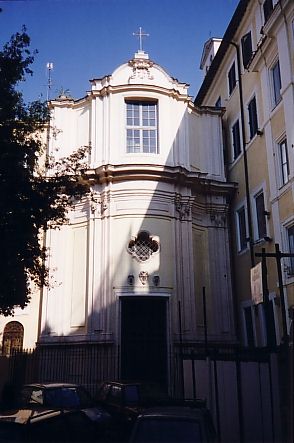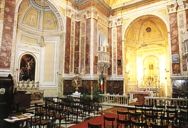

The history and the name of the church
The first church on this site was dedicated to St. Nicholas († c. 350), bishop of Myra in Lycia. The church dated back to the
13th century and was called San Nicolà de Curte, where Curte alludes to the Court of the ancient
Roman noble family of the Orsini, who had their palace nearby. The church is mentioned for the first time in 1320 in a catalogue
listing the churches of Rome as "Ecclesia Sancti Nicolai de Curte". The church of St. Nicholas is reported to have had other
by-names, e.g. "S. Nicolai post Campum Florae", which roughly means St. Nicholas behind Campo dei Fiori, "S. Nicolai prope domum
de Capiteferro", which translates into St. Nicholas near the house of Capo di Ferro, and "San Niccolò della Catena" ("catena"
is the Italian word for chain or shackle).
In 1507 pope Julius II (1503-1513) entrusted the church of St. Nicholas to the people of Viterbo and the Maremma district to
be their national church. Two years earlier the pope had visited the city of Viterbo and the sanctuary of Santa Maria della Quercia
(Saint Mary of the Oak), where a miraculous image with the same name is venerated. Legend has it that the image got its name
from the fact that a peasant had hung it upon the trunk of an oak tree (quercia). Julius II, who in fact had an oak tree as his
heraldic symbol, wanted to diffuse the cult of this image in Rome.
In 1523 the community of Viterbo relinquished the church of St. Nicholas to the Confraternita dei Macellai, the Butchers'
confraternity, which until then had had its liturgical gatherings in the church of Santi Sergio e Bacco at the Forum Romanum. In
1532 pope Clement VII (1523-1534) officially confirmed the confraternity and its proprietorship of the, by then dilapidated, church
of St. Nicholas. In time the confraternity had the church restored and renamed it Santa Maria della Quercia, by which name it
is still known today.
At the beginning of the 18th century the confraternity began to plan a reconstruction of the church ab imis, and in 1728 pope Benedict
XIII (1724-1730) laid the foundation-stone. The pope had commissioned his fellow countryman from Benevento near Naples, Filippo
Raguzzini (1680-1771) to design the new church. Raguzzini is the architect of the Roman rococo, and the church of Santa Maria
della Quercia is considered to be his masterpiece. In his work Raguzzini was assisted by Carlo de Dominicis (1696-1758), but when
the pope died in 1730, they both were substituted by Domenico Gregorini (1692-1777). In 1731 the church was opened for worship,
and a copy of the image of the Madonna della Quercia was placed above the high altar, but the church wasn't consecrated until 1738.
In 1864 the church was reconsecrated after a thorough-going restoration by Andrea Busiri-Vici (1817-1911). In 1928 the church,
having been abandoned for some time, was restored anew. Another renovation took place in 1960 by Marcello Caccia and Luigi Fabrizi,
and the following year the church was reopened.
The art and the architecture of the church
The façade of the church of Santa Maria della Quercia is the work of Filippo Raguzzini, and it is one of very few examples of
Roman sacral rococo architecture.
The quite small interior of the church is bright and when fully lit flowing with light. There
is not one single spot on the walls, that's not decorated with either paintings, frescoes, stucco or marble! However the present
appearance of the interior isn't what Raguzzini once conceived; it dates back to the restoration by Busiri-Vici in 1864. The marble and stucco decorations were executed by Paolo Croppi Lega from Forlì, and Guido Molinari embellished the cupola, the
pendentives and the lunettes above the chapels with frescoes. In the cupola Molinari painted The Litanies of the Virgin with
Angels. The pendentives have four Prophets: Isaiah, Moses, David and Ezekiel. The lunette above the high altar chapel has
The Coronation of the Virgin, while the lunettes above the right and left chapels have The Marriage of the Virgin
and The Presentation of the Virgin at the Temple respectively. The high altar was designed in 1738 by Gregorini, but it
was modified in 1864. The painting above the altar, Madonna della Quercia, may be a
copy of a painting by the school of Carracci. The painting of the right altar, The Baptism of Christ, is attributed to
the 18th century painter Pietro Barbieri. The left altar has a Crucifixion, attributed to Filippo Evangelisti (1684-1761),
but more probably it is executed by Marco Benefial (1684-1764).
The marble and stucco decorations were executed by Paolo Croppi Lega from Forlì, and Guido Molinari embellished the cupola, the
pendentives and the lunettes above the chapels with frescoes. In the cupola Molinari painted The Litanies of the Virgin with
Angels. The pendentives have four Prophets: Isaiah, Moses, David and Ezekiel. The lunette above the high altar chapel has
The Coronation of the Virgin, while the lunettes above the right and left chapels have The Marriage of the Virgin
and The Presentation of the Virgin at the Temple respectively. The high altar was designed in 1738 by Gregorini, but it
was modified in 1864. The painting above the altar, Madonna della Quercia, may be a
copy of a painting by the school of Carracci. The painting of the right altar, The Baptism of Christ, is attributed to
the 18th century painter Pietro Barbieri. The left altar has a Crucifixion, attributed to Filippo Evangelisti (1684-1761),
but more probably it is executed by Marco Benefial (1684-1764).
On the counterfaçade is the 18th century cantory with its plant ornaments and cherubs' heads. The oratory, on the left hand as you enter the church, has an inscription plate in the pavement, commemorating the visit by pope Sixtus V (1585-1590) in 1589. In the sacristy, to the right of the entrance, there are several works of art. The vault has a painting depicting the Virgin with the Child Jesus and Saints. Other paintings show the Annunciation, the Holy Family, the Mocking of Christ, and the Enthroned Madonna with St. Francis of Assisi. There is also an 18th century statue of St. Anthony of Padua here.